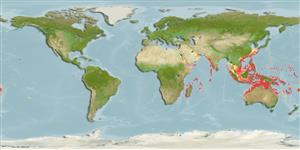Classification / Names
Common names from other countries
Main reference
Size / Weight / Age
Max length : 160 cm TL male/unsexed; (Ref. 2334); max. published weight: 28.0 kg (Ref. 6390); max. reported age: 8 years (Ref. 6390)
Length at first maturity
Lm ? range ? - ? cm
Environment
Marine; brackish; reef-associated; depth range 0 - 140 m (Ref. 30573), usually 1 - 73 m (Ref. 90102)
Climate / Range
Tropical, preferred 28°C (Ref. 107945); 31°N - 31°S
Distribution
Indo-West Pacific: Persian Gulf (Ref. 68964), Red Sea and East Africa (including Madagascar, Mauritius and Seychelles) to the Philippines, north to China, south to Australia. Also from Vanikolo Island (Santa Cruz Islands) and the Solomon Islands. Possibly occurring in the Gulf of Aden, Gulf of Oman and Sri Lanka (Ref. 9997).
Countries | FAO areas | Ecosystems | Occurrences | Introductions
Short description
Dorsal
spines
(total): 0;
Dorsal
soft rays
(total): 0;
Anal
spines: 0;
Anal
soft rays: 0. A small, spindle-shaped shark with a long, rounded snout, large circular eyes, and oblique-cusped serrated teeth; 2nd dorsal fin very low; interdorsal ridge present (Ref. 5578). 2nd dorsal, pectorals and lower caudal lobe with dark tips; 1st dorsal with thin but conspicuous dark tip; pelvic fins and upper caudal lobe plain (Ref. 5485). Grey or grey-brown above, white below with a golden-brown sheen on the area between eyes and gill slits (in fresh specimens); pectorals, second dorsal, and lower caudal fin lobe with conspicuous black tips, first dorsal and upper caudal fin lobe with black edging (Ref. 9997). A dark band on flank extending rearwards to pelvic fins (Ref. 9997).
IUCN Red List Status (Ref. 115185)
Human uses
Fisheries: minor commercial
More information
ReferencesAquacultureAquaculture profileStrainsGeneticsAllele frequenciesHeritabilityDiseasesProcessingMass conversion
Tools
Special reports
Download XML
Internet sources
Estimates of some properties based on models
Phylogenetic diversity index
PD50 = 0.5000 many relatives (e.g. carps) 0.5 - 2.0 few relatives (e.g. lungfishes)
Trophic Level
4.2 ±0.5 se; Based on diet studies.
Resilience
Very Low, minimum population doubling time more than 14 years (K=0.34; tm=2-3; tmax=8; Fec=3)
Vulnerability
Moderate to high vulnerability (51 of 100)
Price category
